Juvenile delinquency refers to antisocial or illegal behavior by children or adolescents and is considered a serious problem all over the world. It is caused by social, economic and cultural factors. This juvenile criminality is apparent in marginal sectors of urban areas where children are exposed to violence in their immediate social environment, either as observers or as victims. Because delinquents basic education, if they have any, is poor they have been marginalized from society and destitute of any dignity or self esteem. Although most legal systems prescribe specific procedures for dealing with young criminals, such as juvenile detention centers and suppression, approaches to prevent youth from becoming delinquent should also include measures to instill equality and justice, fight poverty and create an atmosphere of hope and peace among youth. These preventive policies should be given priorities over any coercive measures.
Read the text and do the comprehension questions. (SOURCE: myenglishpages.com)
Who is the Juvenile?
‘Before the establishment of juvenile courts, children under the age of seven were never held responsible for criminal acts. The law considered them incapable of forming the necessary criminal intent. Children between the ages of 7 and 14 were generally thought to be incapable of committing a criminal act, but this belief could be disproved by showing that the youth knew the act was a crime or would cause harm to another and committed it anyway. Children over the age of 14 could be charged with a crime and handled in the same manner as an adult.
Today, all states set age limits that determine whether a person accused of a crime is treated as an adult or as a juvenile. In most states, young people are considered juveniles until age 18. However, some states set the limit at 16 and 17.
In most states, a juvenile charged with a serious crime, such as robbery or murder, can be transferred to criminal court and tried as an adult. Sometimes prosecutors make this decision, or some states that allow transfers require a hearing to consider the age and record of the juvenile, the type of crime, and the likelihood that the youth can be helped by the juvenile court. As a result of a get-tough attitude involving juvenile crime, many states have revised their juvenile codes to make it easier to transfer youthful offenders to adult court.
Recent years have seen an increase in serious crime by juveniles. This has included more violent acts, such as murder, which are often related to drugs, gangs, or both. Consequently, there has been a movement in congress and in a number of states to further reduce the age at which juveniles can be tried as adults. Some people believe all juveniles should be tried as adults if they commit certain violent crimes.’ Read article
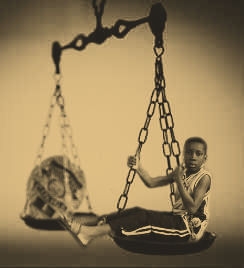 ‘Originally the term juvenile delinquent referred to any child found to be within the jurisdiction of a juvenile court. It included children accused of status offenses and children in need of state assistance. The term delinquent was not intended to be derogatory: its literal meaning suggested a failure of parents and society to raise the child, not a failure of the child.
‘Originally the term juvenile delinquent referred to any child found to be within the jurisdiction of a juvenile court. It included children accused of status offenses and children in need of state assistance. The term delinquent was not intended to be derogatory: its literal meaning suggested a failure of parents and society to raise the child, not a failure of the child.
The modern trend is to separate and label juveniles based on the reason for their juvenile court appearance and the facts of their case. Many states have created three categories for juveniles: delinquents, abused or neglected children, and children in need of services. Delinquents are juveniles who have committed acts that would result in criminal prosecution if committed by an adult. Abused or neglected children are those who are suffering from physical or emotional abuse or who have committed status offenses or petty criminal offenses. Children in need of services are ones who are not abused or neglected but are needy in some other way. These children are usually from impoverished homes and require improved nutrition and basic healthcare.
Generally, the procedures for dealing with abused, neglected, and needy children are less formal than the procedures for dealing with alleged delinquents. The subsequent treatment of non delinquent juveniles by the courts is also markedly different from the treatment of delinquents. Separation of noncriminal cases from criminal cases removes some of the stigma attached to appearance in juvenile court.
The mission of juvenile courts differs from that of adult courts. Juvenile courts do not have the authority to order punishment.Instead, they respond to juvenile misconduct and misfortune by ordering rehabilitative measures or assistance from government agencies. The juvenile court response to misconduct generally is more lenient than the adult court response.
Juvenile court proceedings are conducted in private, whereas adult proceedings are public. Also, whereas adult criminal courts focus on the offense committed and appropriate punishment, juvenile courts focus on the child and seek to meet the child’s needs through rehabilitation, supervision, and treatment. Adult courts may deprive adults of their liberty only for the violation ofcriminal laws. Juvenile courts, by contrast, are empowered to control and confine juveniles based on a broad range of behavior and circumstances.’ Read article
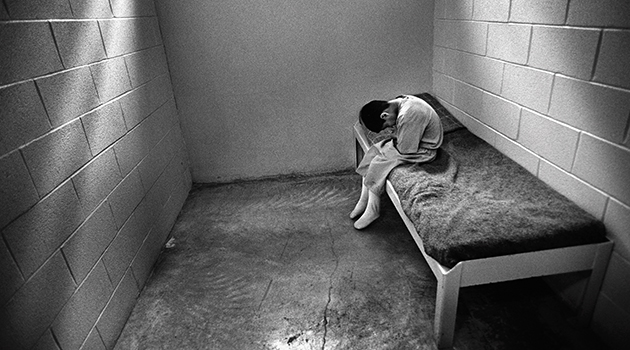
“I haven’t seen sunlight in two years,” the teenager said. Read article:Kids in Cages (SOURCE: alcalde.texasexes.org)
Conversation Questions
Watch the following video & describe it. How does the individual manage prison life?
Describe the case.
When a twelve or sixteen-year-old steals property or evades paying a fare on public transportation, should he or she be tried and sentenced as an adult? Experts from law enforcement, mental health, and other relevant areas feel that counseling and intervention programs are the way to handle minor misdeeds of juveniles. If not, juveniles treated as adults might end up commiting much more serious crimes like assault or murder.
Read Article (with Lesson Plan )
The Plight of Juvenile Criminals (SOURCE: esl-voices.com)
Why should we treat a 14 year old offender differently than a 24 year old offender? (SOURCE: pbs.org)
Is the system racially biased? (SOURCE: pbs.org)
TEEN CRIME RISK FACTORS
Research over recent years has found some factors that are likely to increase the chance of youths becoming involved in offending. There are some risk factors that increase the chances of younger people committing crimes. These are:
- Peer group pressure
- Peer involvement in problem behaviour
- High proportion of unsupervised time with peers
- Parental criminality
- Poor parental discipline and supervision
- Low family income
- Social isolation

- Alienation
- Family conflict
- Drug or alcohol misuse
- Mental illness
- Troubled home life
- Poor educational attainment
- Lack of skills
- unemployment
- Truancy
- Disruptive behaviour such as aggression, hyperactive, bullying
- School disorganisation
- School exclusion
- Deprivation such as poor housing, homelessness
- Lack of social commitment
- Early involvement in problem behaviour
- Community disorganisation
- Opportunity for crime
- Availability of drugs
- High percentage of children in the community. Read article (SOURCE: acs.edu.au)
Top 10 risk factors in childhood for future offending and/or antisocial behaviour
| Risk factors for children under 13 | Risk factors for adolescents 13 and over | ||
|---|---|---|---|
| 1 | History of antisocial behaviour, behaviour problems, conduct disorder during childhood (lying, stealing, bullying, non-compliance, etc.) including contact with the law and arrest before age 12. | 1 | Contact with antisocial peers (those involved in law-breaking, drugs, violence, gangs, etc.) (the more peers or contact, the higher the risk) from age 13 onwards. |
| 2 | Use of tobacco, alcohol and/or other drugs, either weekly or more frequently, before age 12. | 2 | General offences, number or prior offences (the more prior offences, the higher the risk before the current age). |
| 3 | Male gender. | 3 | Aggression, fighting, violent offences. |
| 4 | Low self-control, impulsive, poor ability to stop and think before acting during childhood. | 4 | Low self-control, impulsive, poor ability to stop and think before acting. |
| 5 | Hyperactive, poor ability to pay attention during childhood. | 5 | Hyperactive, poor ability to pay attention. |
| 6 | Involved in fighting, aggression, acts of violence before age 12. | 6 | Poor supervision by parents/caregivers (knowing where young person is, who they are with, rules and consequences). |
| 7 | Low family income during childhood. | 7 | Low levels of warmth, affection and closeness between parent(s) and young person. |
| 8 | Neither parent had skilled work (that is, one or both are unemployed or in unskilled or semi-skilled jobs). | 8 | Tendency towards anxiety, stress. |
| 9 | Neither parent left school with any qualifications. | 9 | Few friends and social/recreational activities. |
| 10 | One or both parents has a history of antisocial criminal behaviour. | 10 | Length of first incarceration (the longer the period, the greater the risk). |
 Read article: What causes youth crime, and what can we do about it? (justice.govt.nz)
Read article: What causes youth crime, and what can we do about it? (justice.govt.nz)
Cide Words (SOURCE: fun-with-words.com)
List of types of killing (SOURCE: en.wikipedia.org)
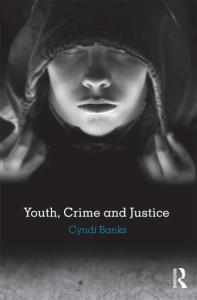
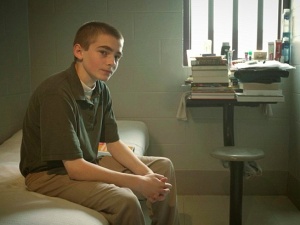
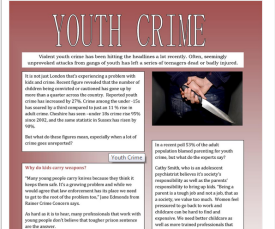
















Excellent! Date: Thu, 9 Apr 2015 15:27:03 +0000 To: alexisjahiel@hotmail.com